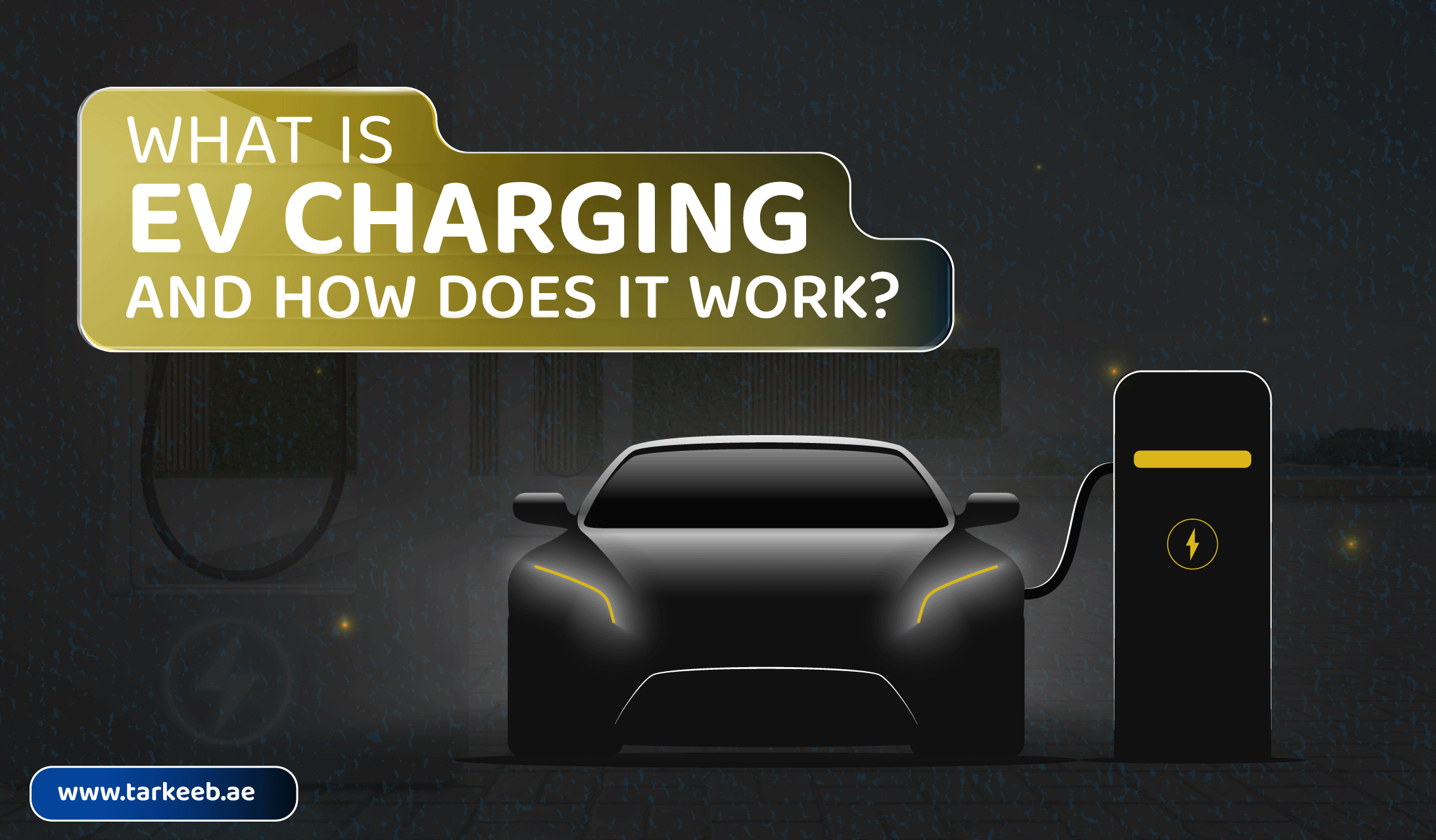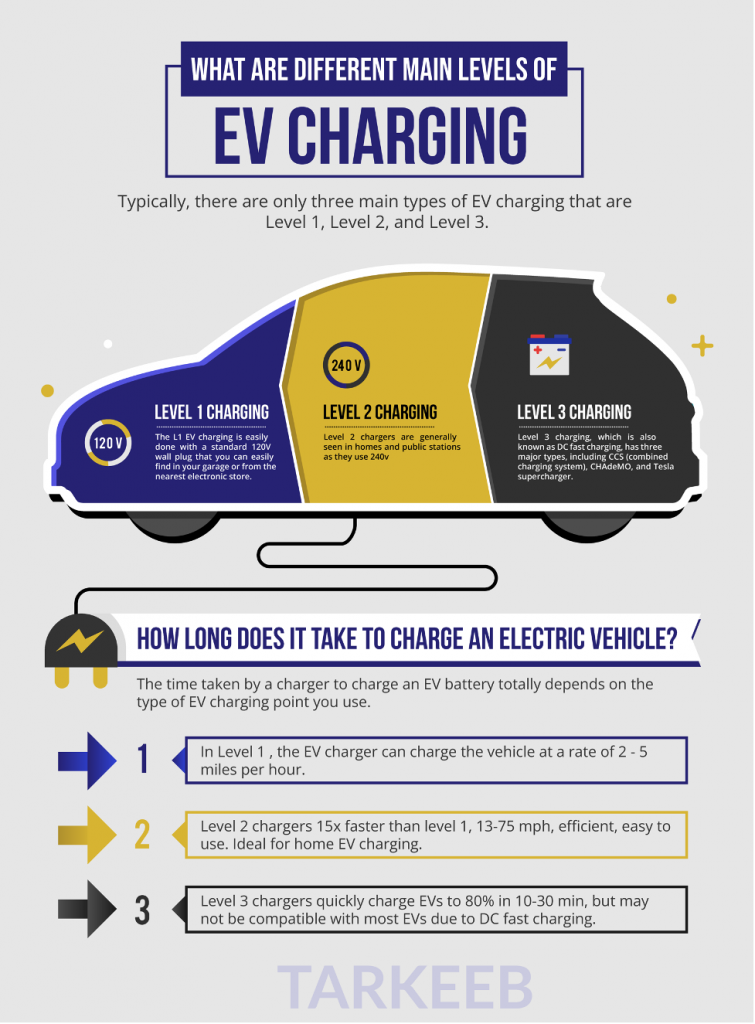
While there is pressure to reduce gasoline-powered cars, electric vehicles are getting popular. The latest technology is much improved and is tempting people to drive electric vehicles. One of the major concerns of people about these cars is how long is the battery life. Obviously, you do not want your cars to run out of power while you drive. Therefore, many areas have installed charging stations, allowing people to keep their batteries charged and reach their destinations. So, what is EV charging, and how does it work? Let’s find out in this blog post.
EV charging is defined as the process of using EV equipment to charge the car’s battery. Like a mobile phone, electric vehicles need to be charged to continue to run with enough power in the battery. So, EV charging stations charge an EV. The term for the EV charging station is technically known as EVSE (electric vehicle supply equipment).
Rather than waiting on the EV stations, you can charge your EV at home as well with the home charging station.
There is a residential EV charging which means charging the vehicle at home with the level 2 EV charger. However, commercial EV charging refers to charging EV fleets, multiple units, and workplace electric vehicle charging. Commercial EV charging stations are used by customers and employees. Most of them are open to the general public as well.
The latest trends and data show that more people will buy EVs in the coming years and will avoid buying conventional gasoline-powered cars in the future.
The key difference between both vehicles is that EVs produce zero emissions, while cars with combustion engines push carbon emissions directly into the air as soon as the cars are turned on. So, with traditional cars, your health is always at risk, also, for the people around you.
Moreover, electric vehicles are clear as they run on battery, not diesel or gasoline. You need to charge the EVs rather than fuel up. In this article, we have explained everything about EV charging and how it works.
In EV charging, the charger uses the electrical grid to pull electric current and transfer it to an electric vehicle through a plug or a simple connector. This energy is stored by the electric vehicles in the large battery that will give power to the electric motor which runs the car.
So, you need to plug the EV charger’s connector into the inlet of the electric car to recharge an EV. Using the charging cable, you can charge the EV batteries that only accept DC (direct current) power. So, you better look for efficient and fast EV chargers. What are the Different Main Levels of EV Charging?

Typically, there are only three main types of EV charging that are Level 1, Level 2, and Level 3. These are generally known as rapid charging or DC fast charging.
Let’s discuss each level in detail.
The L1 EV charging is easily done with a standard 120V wall plug that you can easily find in your garage or from the nearest electronic store. Level 1 charging is comparatively slow and commonly used for overnight home charging the vehicle. It may take more than 24 hours to charge the EV battery through level 1 charging completely.
Level 2 chargers are generally seen in homes and public stations as they use 240v. Compared to level 1, level 2 chargers are 15 times faster. However, Level 2 charging stations require a dedicated 208-/240V outlet, which is the kind of outlet typically used for an electric clothes dryer.
Most homes do not have an additional outlet of this type in their garages or driveway. Therefore, you will need a dedicated circuit which has to be installed by a professional electrician. Rapid chargers or DC fast chargers that use 480+ volts can quickly charge an electric car in level 2.
You should also know that Level 1 and 2 chargers give electric current (AC) to an electric vehicle, which is then converted into DC by the electric vehicle battery because an EV battery can only run on DC power. In comparison, a DC fast charging station delivers Direct Current to the electric vehicle, and the current does not need to be converted at all. Hence, level 1 and level 2 EV chargers are much slower because of the AC/DC conversion of the currents.
Level 3 charging, which is also known as DC fast charging, has three major types, including CCS (combined charging system), CHAdeMO, and Tesla supercharger.
A combined charging system allows AC/DC charging through the same port, but for CHAdeMO, cars have a dedicated port for AC charging.
It is worth mentioning that not all EVs can get charged through a DC fast charger. These DC fast charges are commonly used in commercial applications. So, you may not see them installed in homes for many reasons. Generally, homes do not have enough electrical capacity to work with a DC rapid charger. Most EV drivers do not need fast charging overnight. The installation of DC fast charging is more expensive than level 2 because of the improvement made in the electrical infrastructure.
So, a DC fast charging station is an ideal solution to charge your EV only when there are commercial applications involved. Typically, DC fast chargers are considered the best choice for fleet charging and for public EV charging stations on long highways.
The time taken by a charger to charge an EV battery totally depends on the type of EV chargingpoint you use. Here is the breakdown of the times considering the levels of charging.
Get the most out of the best EV chargers in Dubai with home station installation.
Charging times rely on the battery size, the output of the dispenser, and other factors. Still, many vehicles can get an 80% charge in about or under an hour using the most presently available DC fast chargers.
We are a certified channel partner and installer for MCharger EV chargers in Dubai, UAE. Although the MChargers are made in Germany, it is ideal for the market in UAE because of their ability to tolerate heat, AC charging power, relatively low cost, and warranty of 3 years.
These charges are fast and compatible with all European, American, and GCC-made electric vehicles. Moreover, you can use them for Chinese electric vehicles with GB/T adapters.
The features of MChargers include power up to 22kW, IP55 protection, color display, overvoltage protection, and operating temperature of up to 60°C. Moreover, it offers electrical connections from the top, bottom, or back.
At target, we offer chargers and the best installation services to customers across the UAE. Moreover, we are known for our special fabrication and work according to the custom requests from the clients, such as mounting poles, white labeling, casings for wall-mounted, and others.
Installation of a home charging station is an excellent way to enjoy EV ownership further and release stress. It is safe to use a home EV charging station. It is comparatively convenient and cheaper than public charging. You may love the experience of home charging, and you may never want to go to the public EV charging points again.
It is easier to charge an electric vehicle at home. All you need is to put the connector into the inlet of the EV after the installation of the EV charger. After that, you will have to wait until it finishes charging your car battery completely.
You may want to ensure to charge while the demand is low, and you can benefit from off-peak demand pricing. The chances are that you will find overnight charging the options for yourself.
The installation of the EV home charging station is a tricky part, but not with Tarkeeb. We make the process seamless and provide the best services as per the client’s requirements.
It may look evident, but with a conventional gas vehicle, you can only fill up your car tank at a gas station. But, with an EV, you can charge your vehicle everywhere: at home, at a restaurant, at the office, while shopping, parked on the street, etc., easily.
So, the decision to get an EV and considering how to charge EV go hand in hand. It works a little more uniquely than what we are all already acquainted with. So, it may get rather confusing, specifically because there are multiple new definitions you need to cover your head about.
As per a study by the US Department of Energy’s NREL (National Renewable Energy Laboratory), EV drivers can save as much as approximately $15 000 on fuel costs by driving an electric vehicle instead of a combustion engine vehicle.
The expense to charge an EV relies on where you are charging, the efficiency of your EV, region, vehicle use, and time of day. The analysis found the national average to charge an EV was $0.15/kWh.
How does that compare to the cost of driving a car with an internal combustion engine? The cost per mile varies between $0.13 to $0.22 per gallon, with gas prices at $3 to $4 (as you know, gas costs fluctuate all the time, and this estimation could be at the low end).
With such a significant difference, people prefer going towards EVs as it is the future of moving from one place to another without disturbing nature.
Establishing a home charging station or equipping your facility with a charging point can become overwhelming. Still, it won’t be if you connect with us, a skilled and respected EV charging company. Tarkeeb is persistent in maximizing the potential of every watt, and we have revolutionized the EV charging installation process by making it easier to get a quote and get you the EV charging solution you desire.
So, connect with our professional team of EV charging experts, who can support you in figuring out what type of residential or commercial EV charging you require and how to save money on chargers and installation charges. Connect with us to initiate your EV charging journey!
EV charging is defined as using EV equipment to charge the car’s battery. Like a mobile phone, electric vehicles need to be charged to run with sufficient power in the battery.
In general, there are three kinds of EV charging that include Level 1 (Slow Charging), Level 2 (Fast Charging), and Level 3 (Rapid Charging).
The straightforward response to the question is no. Usually, you should not charge your electric vehicle every night. It is optional in most cases. The approach of charging an electric vehicle each night can shrink the lifespan of the EV’s battery pack.
At your convenience, you can pay with a debit card or contactless credit. Many grids now take contactless credit or debit card payments; generally speaking, charge point operators are improving the services to make payment easier for Electric Vehicle drivers. Easy, fast, and accessible payment fits most people.